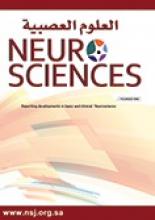Research ArticleOriginal Article
Open Access
Protective role of astragalus injection in spinal cord ischemia-reperfusion injury in rats
Liya Zhou, Zhenfei Song, Liwen Zhou, Yongchi Qiu, Nan Hu, Yong Hu and Xingming Hu
Neurosciences Journal April 2018, 23 (2) 116-121; DOI: https://doi.org/10.17712/nsj.2018.4.20170391
Liya Zhou
From the Department of Orthopedics (Zhou Li-ya, Song, Qiu, Hu N, Hu Y, Hu X), Xiangyang Hospital of Traditional Chinese Medicine, Department of Anesthesiology (Zhou Li-wen), Xiangyang Central Hospital, Affiliated Hospital of Hubei University of Arts and Science, Xiangyang, China
MD, PhDZhenfei Song
From the Department of Orthopedics (Zhou Li-ya, Song, Qiu, Hu N, Hu Y, Hu X), Xiangyang Hospital of Traditional Chinese Medicine, Department of Anesthesiology (Zhou Li-wen), Xiangyang Central Hospital, Affiliated Hospital of Hubei University of Arts and Science, Xiangyang, China
MBLiwen Zhou
From the Department of Orthopedics (Zhou Li-ya, Song, Qiu, Hu N, Hu Y, Hu X), Xiangyang Hospital of Traditional Chinese Medicine, Department of Anesthesiology (Zhou Li-wen), Xiangyang Central Hospital, Affiliated Hospital of Hubei University of Arts and Science, Xiangyang, China
MD, PhDYongchi Qiu
From the Department of Orthopedics (Zhou Li-ya, Song, Qiu, Hu N, Hu Y, Hu X), Xiangyang Hospital of Traditional Chinese Medicine, Department of Anesthesiology (Zhou Li-wen), Xiangyang Central Hospital, Affiliated Hospital of Hubei University of Arts and Science, Xiangyang, China
MSNan Hu
From the Department of Orthopedics (Zhou Li-ya, Song, Qiu, Hu N, Hu Y, Hu X), Xiangyang Hospital of Traditional Chinese Medicine, Department of Anesthesiology (Zhou Li-wen), Xiangyang Central Hospital, Affiliated Hospital of Hubei University of Arts and Science, Xiangyang, China
MSYong Hu
From the Department of Orthopedics (Zhou Li-ya, Song, Qiu, Hu N, Hu Y, Hu X), Xiangyang Hospital of Traditional Chinese Medicine, Department of Anesthesiology (Zhou Li-wen), Xiangyang Central Hospital, Affiliated Hospital of Hubei University of Arts and Science, Xiangyang, China
MBXingming Hu
From the Department of Orthopedics (Zhou Li-ya, Song, Qiu, Hu N, Hu Y, Hu X), Xiangyang Hospital of Traditional Chinese Medicine, Department of Anesthesiology (Zhou Li-wen), Xiangyang Central Hospital, Affiliated Hospital of Hubei University of Arts and Science, Xiangyang, China
MB
References
- ↵
- Cheung AT,
- Weiss SJ,
- McGarvey ML,
- Stecker MM,
- Hogan MS,
- Escherich A,
- et al.
- ↵
- Carroccio A,
- Marin ML,
- Ellozy S,
- Hollier LH
- ↵
- Acher C,
- Wynn M
- ↵
- Acher C,
- Wynn M
- ↵
- Bobadilla JL,
- Wynn M,
- Tefera G,
- Acher CW
- ↵
- Mechírová E,
- Domoráková I,
- Danková M,
- Danielisová V,
- Burda J
- ↵
- Luo Y,
- Qin Z,
- Hong Z,
- Zhang X,
- Ding D,
- Fu JH,
- et al.
- ↵
- Chen J,
- Yuan M,
- Zheng L
- ↵
- Drug Standard of Ministry of Public Health of the Peoples Republic of China
- ↵
- Xie W,
- Zhao Y,
- Zhang Y
- ↵
- Chen CC,
- Lee HC,
- Chang JH,
- Chen SS,
- Li TC,
- Tsai CH,
- et al.
- ↵
- Luo Y,
- Qin Z,
- Hong Z,
- Zhang X,
- Ding D,
- Fu JH,
- et al.
- ↵
- Liu G,
- Song J,
- Guo Y,
- Wang T,
- Zhou Z
- ↵
- Zivin JA,
- DeGirolami U
- ↵
- Xiang L,
- Li Z
- Shi Yan Mei,
- shi-chang
- ↵
- Xie W,
- Zhao Y,
- Zhang Y
- ↵
- Celtik C,
- Acunas B,
- Oner N,
- Pala O
- ↵
- Berger RP,
- Bazaco MC,
- Wagner AK,
- Kochanek PM,
- Fabio A
- ↵
- Costine BA,
- Quebeda-Clerkin PB,
- Dodge CP,
- Harris BT,
- Hillier SC,
- Duhaime AC
- ↵
- Fang bo,
- Sun Xuejun,
- Wang He,
- Zhao Xi,
- Ma Hong
- ↵
- Wang He,
- Li Xiaoqian,
- Ma Hong
- ↵
- Douglas-Escobar M,
- Weiss MD
- ↵
- Preston GM,
- Carroll TP,
- Guggino WB,
- Agre P
- ↵
- Shen L,
- Zhu Z,
- Huang Y,
- Shu Y,
- Sun M,
- Xu H,
- et al.
- ↵
- Amiry-Moghaddam M,
- Frydenlund DS,
- Ottersen OP
- ↵
- Nesic O,
- Guest JD,
- Zivadinovic D,
- Narayana PA,
- Herrera JJ,
- Grill RJ,
- et al.
- ↵
- Nesic O,
- Lee J,
- Ye Z,
- Unabia GC,
- Rafati D,
- Hulsebosch CE,
- et al.
- ↵
- Huang F,
- Li YN,
- Yin F,
- Wu YT,
- Zhao DX,
- Li Y,
- et al.
In this issue
Protective role of astragalus injection in spinal cord ischemia-reperfusion injury in rats
Liya Zhou, Zhenfei Song, Liwen Zhou, Yongchi Qiu, Nan Hu, Yong Hu, Xingming Hu
Neurosciences Journal Apr 2018, 23 (2) 116-121; DOI: 10.17712/nsj.2018.4.20170391
Jump to section
Related Articles
- No related articles found.
Cited By...
- No citing articles found.





